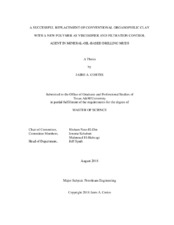| dc.description.abstract | Oil-based drilling fluids (OBDF) can enhance wellbore stability in water-sensitive reservoirs and protect metal surfaces of drilling equipment to minimize corrosion due to H2S and CO2. Components of OBDF include oil as the continuous phase and water as the dispersed phase, in conjunction with viscosifiers, emulsifiers, filtration control agents, and weighting materials. Two of the most common types of continuous phases in oil-based drilling fluids are diesel and mineral oil. Mineral oil is less toxic than diesel, and oil retention properties of OBDF with mineral oil are less than OBDF with diesel. Organophilic clays are clay minerals that have been treated with oil-wetting agents, which will make the clay oil-dispersible. Organophilic clays mixed in OBDF do not exhibit same viscosity or suspension characteristics as in water-based drilling fluids, because electrical interaction between particles is minimal, making it difficult to build viscosity and gel strength in high pressure and high temperature (HP/HT) wellbore conditions. A new mineral-oil-based drilling fluids (MOBDF) proposed was obtained by the successful replacement of conventional organophilic clay additives with a methylstyrene/acrylate copolymer.
Two different drilling fluid formula, one containing conventional organophilic clay additives and the other containing the replacement polymer as a viscosifier and filtration control agent, were hot rolled at 150°F for 16 hours. To evaluate the alteration of the wettability caused by the MBDOF and its components contact-angle measurements were made in the laboratory. With similar weight proportions, the apparent and kinetic viscosities of organophilic clay and cross-linked polymer were also
compared.
Rheological properties and filtration characteristics tests were conducted using a rotational viscometer and a HP/HT filter press, under three simulated wellbore conditions (140°F/ 300 psi, 190°F/300 psi, and 250°F/500 psi). Filter cake is formed due to positive pressure between OBDF and pore throat pressure. As a barrier between wellbore and formation, it can minimize solids and fluids invasion. A core flooding test was conducted to evaluate permeability of the filter cakes and CT scan was used to measure the density distribution of the filter cakes. Emulsion droplets formed by mixing MOBDF filtrate fluids with formation water were observed to analyze emulsion plugging damage.
Experimental results show that the novel polymer has a promising future of practical application, by providing thermal stability and stable rheological properties for MOBDF in HP/HT conditions. It also yields lower filtration volume, higher quality filter cake and a slightly greater emulsion plugging capabilities and greater formation permeability retention than organophilic clay-based drilling fluids. | en |


